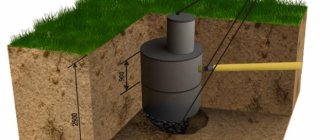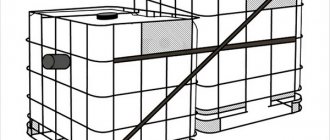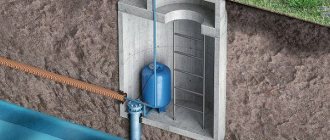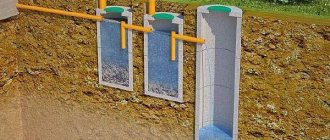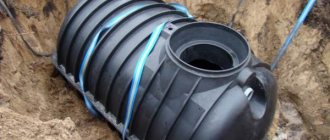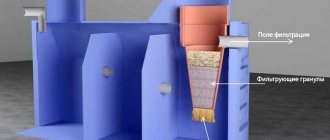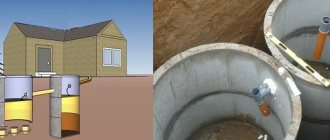The problem of hygiene and comfort always faces a person who decides to move to a permanent place of residence in the private sector, where problems often arise with the shower and toilet familiar to a resident of the “concrete jungle”. Indeed, in such cases, there is often no opportunity to connect your home to centralized communications systems, including the wastewater disposal system. And that is why, before building the house itself, most land owners plan to install a sewer system in their dacha. How to make a septic tank for a home, what is needed for this and how difficult is it?
How to make a septic tank in a private house
Septic tank - what is it?
“What is a Shambo septic tank, its drawing can be viewed in our article.” A septic tank is one of the most important elements of the sewerage system, which is equipped on the territory of a private house. This sealed structure, usually made of several chambers, is designed to accumulate and then treat domestic wastewater (sewage). Simply put, dirty water settles in it and becomes clean. Septic tanks for a private home, how to choose, price, you can read in our article.
The principle of a simple septic tank
You may be interested in information - septic tank uponor
The septic tank works very simply.
- First, wastewater flows through pipes from the house into one of the chambers of the septic tank - the first, which can be called the primary sump.
- It is here that substances begin to stratify, as it were, being separated by specific gravity. For example, waste and other elements that are heavier than water sink to the bottom. But fats and everything that is lighter than water rises and floats on its surface.
- Next, the settled water flows into the second settling tank, where a similar “screening out” of small fractions occurs.
- Then even cleaner water enters special filtration fields or a filtration well, where it is finally cleaned of contaminants and goes into the ground.
Installation of different types of septic tanks
On a note! Septic tanks do not always have a third chamber. It depends on the type of structure.
It’s quite possible to build such a simple structure yourself, without inviting craftsmen. At the same time, septic tanks are currently being built using new technologies, and therefore often become more profitable than using a centralized sewer system.
You may be interested in information about what the distance from the septic tank to the well should be.
cesspool
Table. The main types of septic tanks.
| View | Description |
| Sealed septic tank or storage tank | This septic tank has a bottom and periodically needs pumping. The design is similar to a cesspool - in other words, it is a regular container for storing wastewater. A design that forces you to regularly spend money on cleaning using vacuum cleaners. |
| Septic tank with biological treatment system | Water treated in such devices requires additional purification. The most effective, but also the most expensive septic tank. |
| Septic tank with filter well | This septic tank is equipped with several settling chambers in which the water is partially purified and then enters a well that filters it, from which it passes, already purified, into the environment. Needs cleaning extremely rarely. |
Exploitation
It's one thing to build a sewer system. The other is to operate correctly so that the system functions at a sufficient level.
So, let's look at how to maintain and operate a septic tank:
- Waste must be drained regularly to ensure bacterial life.
- It is prohibited to drain caustic chemicals (acids, alkalis, petroleum fluids, surfactants, etc.)
- It is necessary to periodically clean out bacterial waste products (silt deposits)
- Do not dump household waste.
If all requirements are met, such a sewer system will serve you for decades.
Cesspool or septic tank - which is better?
You may be interested in information - septic tank uponor
For decades and even centuries, people built ordinary cesspools near their homes and on their plots to arrange a sewer system (if you can call it that).
Tire cesspool
These pits have the following disadvantages:
- fragility of use;
- an ordinary cesspool is not able to cope with large volumes of wastewater, which have increased significantly over the past decades, because private homes now have bathrooms, washing machines, dishwashers, and swimming pools;
- difficulty of maintenance - too large volumes of wastewater will require pumping out waste several times a week, which can hit the pocket hard;
- there is a high risk of wastewater getting into groundwater and environmental pollution - cesspools often do not have a sealed bottom and walls at all:
- an unpleasant odor hovering near the pit;
- problems with neighbors and sanitary inspection services.
Cesspools have many disadvantages
All of the above disadvantages of a cesspool are absent in any properly equipped septic tank. It is more effective, durable, economical, needs cleaning and treatment less often, and for this there is a special product for septic tanks. Although the treatment plant looks very much like a regular cesspool, its filtration system is much more complex. Or rather, in the cesspool it can be said to be completely absent.
You may be interested in information - what is a septic tank for?
However, the construction of a septic tank must also be carried out in accordance with certain sanitary standards - you cannot equip it anywhere and at random. A septic tank can now be purchased in a specialized store or ordered to be built by craftsmen. But it is much cheaper to equip it yourself. Before you start building a septic tank, you will need to create its diagram, determine its dimensions and location.
Two-chamber septic tank
Septic tank Online calculator for the required volume of a septic tank based on the number of residents and water use patterns
You may be interested in information on how to make a sewer system in your country house
Selection of bacteria
A septic tank cannot operate without bacteria. After all, only bacteria perform the main role in decomposing pollutants. Sewage bacteria are divided into two types: aerobic (cannot live without oxygen) and anaerobic (putrefactive).
Anaerobic bacteria live in almost any conditions, unlike aerobic bacteria, which die when there is a lack of oxygen.
But anaerobic bacteria have one big disadvantage: the products of their activity contain solid deposits and produce methane, which contributes to an unpleasant odor. But they do not need pit ventilation. And aerobic bacteria are released into septic tanks for both homes and cottages.
Which bacteria to use is up to you.
Septic tank location: rules
A septic tank cannot be built wherever you want - the structure must be built taking into account all construction and sanitary standards. If the location is chosen correctly, the system will work for many years without complaints and will not raise questions from supervisory authorities in the event of inspections.
Scheme of the permissible location of the septic tank on the site
- The construction of a septic tank made of concrete rings depends on the depth of groundwater in your area and on how deep the soil freezes in your climate zone in winter. For example, groundwater should not flow (at least this is very undesirable, but acceptable if there is high-quality waterproofing) at a distance of less than 1.5 m to the treatment system. And the optimal depth of soil freezing is 1.4 m or less.
- It is best to install a septic tank on sandy, sand-gravel or gravel soils - this will facilitate the organization of the correct filtration process. The worst thing is if your site is located on clay soils.
- The terrain of the site must also be taken into account.
Location of the septic tank on the site
- The distance from the septic tank to the place of clean water intake depends on the soil structure and should be at least 20 m (clayey soil).
- A septic tank cannot be installed next to a residential building or other buildings that have a foundation - the drained water can wash it away. The minimum distance of the sewer system from a residential building is 5 m.
- Also, the septic tank should not be located near roads or fences that separate the site from the neighboring one.
When thinking through the plan and further construction of the house, you should immediately think about the supply of the sewer system
How to calculate dimensions
In order to accurately determine the amount of building materials, it is important to correctly calculate the volume of the septic tank. This indicator depends on the number of people living in the house and the intensity of water use during the day.
You may be interested in information - which septic tank for a dacha is better
Calculating the volume of a septic tank is simple. To do this, you should focus on the average water consumption per day per person - 200 liters. This number is multiplied by the number of people living in the house (for example, 5 * 200 = 1000 l). This is the daily volume of all water consumed by the family. And the resulting number is further multiplied by 3 (the number of days required to purify the water). We get 3000 liters, which is equal to 3 cubic meters. “You can watch a video on how to install a concrete septic tank with your own hands in our article.”
Calculation of the volume of a septic tank for a private house
Now you can determine the dimensions of the septic tank chambers. The volume of the first settling tank will be 3 cubic meters.
On a note! If the water consumption is small (up to 1 cubic meter), then you can build a septic tank according to the simplest scheme - a settling tank and a filter well. If the flow rate is higher, then three-chamber septic tanks are built. If the volumes of wastewater are very large (more than 20 m3), then another additional settling tank is built in front of the well.
What are the dimensions of the autonomous sewage system Topas ↑
Topas equipment is represented by a wide range of models that are capable of processing household waste of any volume.
It is used not only for private houses, but for cottages and serving large numbers of people.
The Topas 5 model processes the minimum amount of wastewater per day, up to 1000 liters per day. The most powerful model Topas 150 is capable of serving 150 people, and 24,000 liters of waste can pass through it per day.
A distinctive feature of these septic tanks is a wide selection of modifications:
- standard models. Available in sizes from 1.1*1.2*2.5 to 4.3*4*3 m (length, width, height);
- equipment with attachment Pr. This means that the system is installed with pumping equipment and requires forced pumping. The dimensions of the device are larger than standard and range from 1.6*1.2*2.6 to 4.2*4*3 m;
- designs with the designation Long. The models have an elongated size, so the device for eight people - Topas 8 has dimensions of 1.6 * 1.2 * 3.1. Topas 30 - 2.3*2.2*3, which completes the Long line;
- septic tanks marked Long Pr mean that they have an elongated top and require forced pumping of wastewater. The range is filled with systems capable of serving from 5 to 30 people per day. The series includes Topas 5, 8, 10, 15, 20 and 30, their sizes range from 1.1*1.2*3.1 to 2.2*2.2*3 m, the maximum volume of waste per day is 6000 l ;
- models with the prefix Long Us mean that the septic tanks are elongated and have a reinforced body. Suitable for installation of structures in floating vessels. Presented in the following options: Topas 10 and 15, have dimensions: 2.1*1.3*3.1 m;
- equipment with the Long Pr Us attachment assumes a robust design, an elongated body and forced waste pumping. Presented for 10 and 15 residents, they have dimensions of 2.1 * 1.3 * 3.1 m.
Photo: dimensions of the Topas septic tank
Materials
You can make a septic tank with your own hands from various materials. They differ in quality, durability, cost and other factors.
Table. What can you build a septic tank from?
| Material | Characteristic |
| Reinforced concrete rings | Quite expensive, but one of the fastest septic tank options to build. The main work is the accurate calculation and installation of concrete rings. It is quite difficult to work with this building material on your own without special equipment, since the rings are heavy. Such a septic tank will have good tightness if assembled correctly. |
| Monolithic cement septic tank | A septic tank, which is a pit in which concrete walls are made using formwork and cement. After the poured cement has hardened, partitions are made in the pit, dividing the container into chambers. Such a septic tank is highly durable, lasts a long time, does not let water through, but is quite expensive and difficult to install. |
| Brick | A common, simple way to build settling tanks. Inexpensive, but durable and reliable. The walls are made of brick. Such a septic tank is reliable, durable, economical, but often may not be completely sealed and takes longer to build than a septic tank made of concrete rings. |
| Plastic containers | Fast and easy. Such a septic tank is made from Eurocubes, which were invented for transporting liquids in large volumes. It is reliable, airtight, inexpensive, but requires certain preparatory work, since the walls of the pit should be further strengthened so that they support the walls of the containers. Such septic tanks are not characterized by large volumes. Purchased septic tanks are also made of plastic. |
| Tires from car wheels | This is a great way to create a septic tank from scrap materials. Most often, it is built in this way at dachas where people do not live permanently. Very large tires are placed in the pits. But, despite its availability and low cost, such a septic tank has its drawbacks - it is not airtight enough and is short-lived. |
Comparison of septic tank Bars-Aero and Bars-Topas
Regulatory Requirements and Regulations
It is necessary to understand that the disposal and disposal of wastewater is clearly regulated by the regulatory documentation of the Russian Federation, non-compliance with which leads to negative consequences both for the ecosystem and for the liability of those responsible. Therefore, when calculating a septic tank for the needs of a household, they rely on a number of standards and rules, in particular:
- SNiP 2.04.03-85 “Sewerage. External networks and structures”, regulating sanitary protection zones around small treatment facilities, as well as adjusting the active volumes of installations.
- SNiP 2.04.01-85 “Internal water supply and sewerage” or their updated version SP30.13330.2012, for determining wastewater flow rates.
- A manual for the design of engineering systems MDS 40-2.200, which provides the main regulatory calculations for the calculation of septic tanks and their auxiliary structures (drainage wells, filtration fields, etc.).
We build a septic tank with our own hands
Let's look at how to make a septic tank on your own from reinforced concrete rings. You can use rings with a diameter of 1 or 2 m - the choice depends on the required volume of the structure.
You may be interested in information - storage septic tank for a summer residence
Step 1. A pit with the required parameters is dug at a distance of at least 5 m from a residential building or other building with a foundation. A concrete base is placed at the bottom of the dug hole, and its thickness cannot be less than 100 mm. It is on this that the concrete rings will be installed. To make the bottom stronger, it can be reinforced with reinforcement. You can also buy a ready-made round base for this. In this case, all joints between concrete parts must be well sealed with cement mortar. If the bottom of the structure is located below the groundwater level, then the structure should also be waterproofed.
Recommended thickness of concrete base
On a note! You can install the rings not in one common hole, but individually. To do this, a ring is installed on the surface of the soil in the right place, and the soil is excavated directly from inside it. Thus, the ring will gradually sink into the ground under its own weight. When one ring goes down, a second one is installed on it, and soil removal work continues.
Step 2. The two upper rings must have inlet and outlet holes; one hole is constructed in the filtration well - the inlet.
Hole in reinforced concrete ring
Step 3. The sewer pipe (inserted into the inlet), through which water will flow into the septic tank, is installed 150 mm above the outlet pipe (otherwise known as the outlet).
Pipe connection
You may be interested in information - septic tank aspen reviews
Step 4. Tees (each diameter is 100 mm) are installed in the outlet holes, equipped with transverse outlets that allow outward flow. A pipe of the same diameter is carefully attached to them - it connects them. In this case, part of the tee pipe is installed vertically so that the lower end drops 300 mm into dirty water, and the upper end rises above the water level. This design will allow the inlet and outlet pipes to be cleaned.
Overflow between septic tank chambers
Three chambers connected to each other
Step 5. The septic tanks are covered with concrete slabs with holes for installing hatches, as well as ventilation holes. To make it possible to clean the outlets, the ventilation holes are located strictly above the tee outlets.
Covers with holes for ventilation and hatches
Step 6. The sewer pipe from a private house is laid in a trench specially dug at the required depth, which has a slope of 5 degrees towards the septic tank. A cushion of sand 5 cm thick is created at the bottom of the trench.
The angle of inclination of the sewer pipe should be 5 degrees
Sand cushion thickness - 50 mm
Step 7. The drain pipes are filled first with sand and then with soil.
Backfilling of the pipeline
Step 8. Concrete rings must be covered with lids, and then hatches and ventilation pipes are installed on them.
Installation of ventilation pipes and manhole covers
Step 9. The septic tank is filled with soil.
You may be interested in information - septic tanks for a private home
Backfilling the septic tank with soil
On a note! Before starting the septic tank, it is necessary to carefully seal all the joints between the pipes and reinforced concrete rings and the gaps.
Prices for concrete rings
concrete rings
Video - DIY septic tank made of concrete rings
You may be interested in information: sewerage for a country house, what to choose
